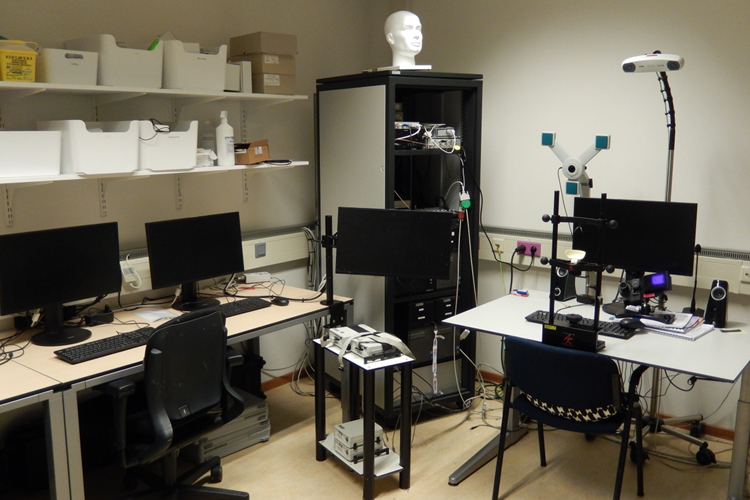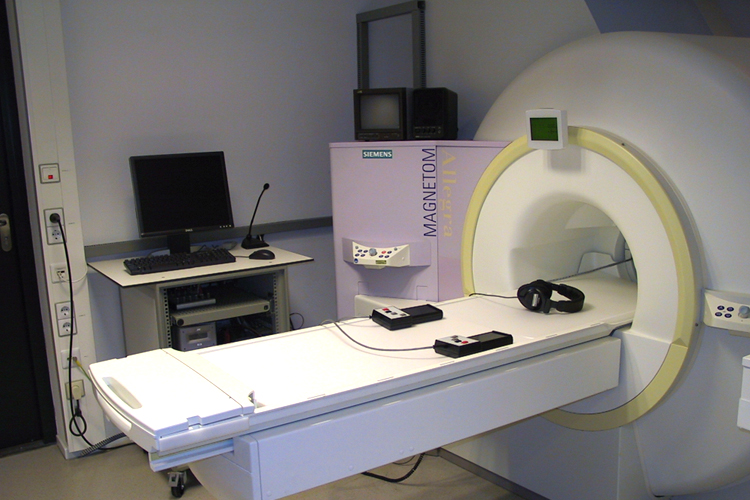TMS
Transcranial magnetic stimulation (TMS) is a neurophysiologic technique that can locally and temporarily disturb or stimulate parts of the brain using a magnetic field, enabling researchers to test their precise functions in carrying out certain behaviour. Thus, TMS may be of importance in answering questions in a variety of research areas, not only in the cognitive neurosciences (e.g. how does a healthy person’s brain work exactly?). This method has also led to impressive results in studies of addictive behaviour, eating disorders, depression and social behaviour. In addition, TMS is used worldwide as therapeutic means, for example in treating psychopathological disorders and rehabilitation after brain damage. The lab is open to cooperation in various fields.
Equipment and application
The lab is fully equipped for research that can combine TMS and fMRI in a novel way. It consists of two stimulators which allow for single-pulse TMS (chronometry of functional relevance), event-related TMS and repetitive TMS (long-term effects), in which different forms of coil (8-shaped and round, placebo coils) can be used. MRI- (or fMRI-) controlled neuronavigation makes precise stimulation possible using the MRI and fMRI data and Talairach coordinates. This is an MR-compatible setup which is one of the few labs worldwide to combine TMS and fMRI simultaneously.
Because of the TMS’s strong magnetic field, specific safety guidelines apply in this lab (certified user, medical supervision, etc.).
If the researcher wants to stimulate a certain brain function in a test participant, the coil must be held in the correct place above the participant’s head. To find the precise spot, the researcher uses the TMS neuronavigation system and a 3D reconstruction of the participant’s head (which is made using MRI data previously acquired from the participant). In many cases, the researcher not only looks at the person’s anatomy, but also at brain activation. It is therefore possible to localise a specific area by having the participant carry out the same task in the MRI scanner.
At the moment of stimulation, a short, strong electric current is sent through the coil, thus generating a brief magnetic field which enters the brain through the skull. The magnetic field of the TMS pulse activates similar types of small electric currents in the connections between the neurons, making it possible to measure functions (e.g. conductive speed or irritability), and temporarily stimulate – or disturb – brain activity.
Combination of TMS and fMRI
The TMS Stimulator is regularly combined with the fMRI scanner. In principle, the two techniques answer the same types of research questions, though each in their own way. The fMRI scanner examines where people’s brain activity is localised, while the TMS tests the relevance of certain brain areas.
There are two ways to combine the functions of the TMS and the fMRI. The first is the experimental combination; here, a test participant carries out a task in the fMRI scanner, while his/her brain activity is recorded. Then, the participant attempts to carry out the same task while the TMS Stimulator stimulates the brain areas s/he used when first carrying out the task. Using this method, it is possible to increase, reduce, or even halt the activity of certain areas in the brain.
The latest innovation in the field of TMS is its simultaneous use with other methods, such as EEG/ERP and fMRI. The latter has recently become possible in Maastricht, too, which makes our lab one of only a handful in the world. In this combination, like in the previous example, a test participant carries out a task in the fMRI scanner. This time, however, the TMS is not used afterwards, but simultaneously with the fMRI. The advantage of this method is that brain activity is measured at the moment of stimulation, which means that it looks directly at changes in behaviour and changing brain reactions in response to the stimulation or inhibition of certain brain areas.
While the test participant carries out the task, certain brain functions can be deactivated through the TMS. When this happens, the brain still tries to carry out the task, even when the necessary functions have been eliminated. In this way it becomes clear that the brain looks for new ways to carry out certain tasks in the event of a specific lesion.
Simultaneous TMS and fMRI complement each other in a unique way and can thus provide insight into this type of compensatory and plastic processes for the first time. This means they may play an important role in steering these processes towards recovery and rehabilitation following brain damage. In addition, visualisation of the change in brain activity after a TMS pulse can yield important information on the precise effect of TMS on the brain.


